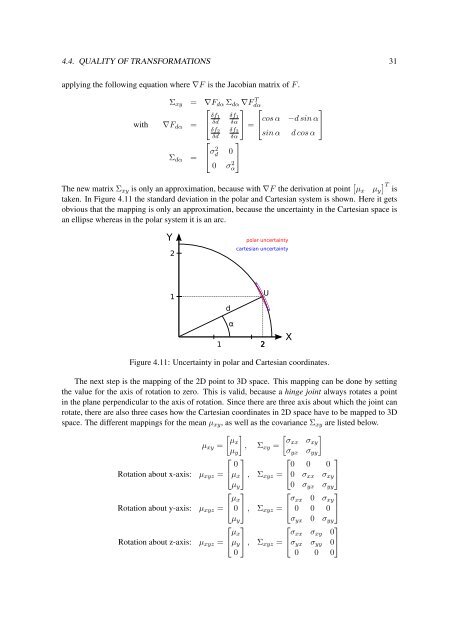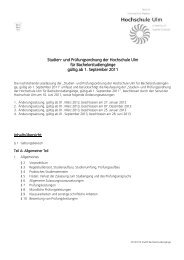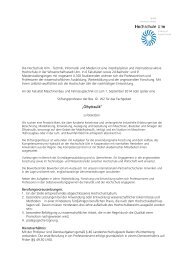PDF 1.938kB
PDF 1.938kB
PDF 1.938kB
You also want an ePaper? Increase the reach of your titles
YUMPU automatically turns print PDFs into web optimized ePapers that Google loves.
4.4. QUALITY OF TRANSFORMATIONS 31<br />
applying the following equation where ∇F is the Jacobian matrix of F .<br />
Σ xy = ∇F dα Σ dα ∇Fdα<br />
T ⎡ ⎤ ⎡<br />
δf 1 δf 1<br />
with ∇F dα = ⎣ δd δα ⎦ = ⎣ cos α<br />
δf 2 δf 2<br />
δd δα<br />
sin α<br />
⎡ ⎤<br />
Σ dα = ⎣ σ2 d<br />
0<br />
⎦<br />
0 σα<br />
2<br />
⎤<br />
−d sin α<br />
⎦<br />
d cos α<br />
The new matrix Σ xy is only an approximation, because with ∇F the derivation at point [ ] T<br />
µ x µ y is<br />
taken. In Figure 4.11 the standard deviation in the polar and Cartesian system is shown. Here it gets<br />
obvious that the mapping is only an approximation, because the uncertainty in the Cartesian space is<br />
an ellipse whereas in the polar system it is an arc.<br />
Y<br />
2<br />
polar uncertainty<br />
cartesian uncertainty<br />
1<br />
d<br />
U<br />
α<br />
1 2<br />
X<br />
Figure 4.11: Uncertainty in polar and Cartesian coordinates.<br />
The next step is the mapping of the 2D point to 3D space. This mapping can be done by setting<br />
the value for the axis of rotation to zero. This is valid, because a hinge joint always rotates a point<br />
in the plane perpendicular to the axis of rotation. Since there are three axis about which the joint can<br />
rotate, there are also three cases how the Cartesian coordinates in 2D space have to be mapped to 3D<br />
space. The different mappings for the mean µ xy , as well as the covariance Σ xy are listed below.<br />
[ ] [ ]<br />
µx<br />
σxx σ<br />
µ xy = , Σ<br />
µ xy =<br />
xy<br />
y σ yx σ yy<br />
⎡ ⎤ ⎡<br />
⎤<br />
0<br />
0 0 0<br />
Rotation about x-axis: µ xyz = ⎣µ x<br />
⎦ , Σ xyz = ⎣0 σ xx σ xy<br />
⎦<br />
µ y 0 σ yx σ yy<br />
⎡ ⎤ ⎡<br />
⎤<br />
µ x<br />
σ xx 0 σ xy<br />
Rotation about y-axis: µ xyz = ⎣ 0 ⎦ , Σ xyz = ⎣ 0 0 0 ⎦<br />
µ y σ yx 0 σ yy<br />
⎡ ⎤ ⎡<br />
⎤<br />
µ x<br />
σ xx σ xy 0<br />
Rotation about z-axis: µ xyz = ⎣µ y<br />
⎦ , Σ xyz = ⎣σ yx σ yy 0⎦<br />
0<br />
0 0 0

















